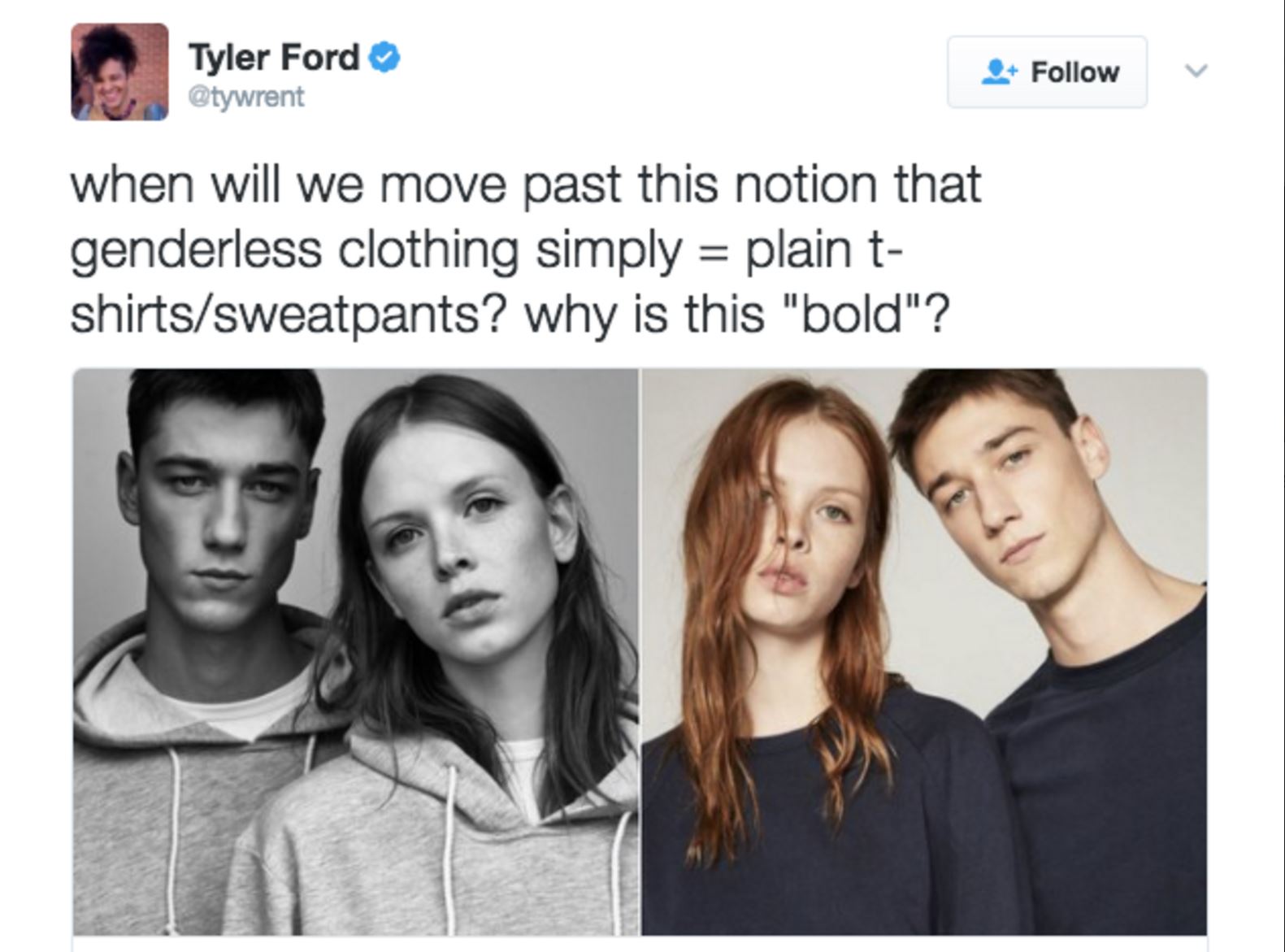Fatphobia and Gender Politics Behind Androgyny in Fashion

Image Source: Tyler Ford on Twitter.
Androgyny in mainstream fashion is not a new phenomenon. With contemporary notions of masculinity and femininity in mind, androgyny can be traced back to the women of the roaring 20s or the men in big-name 60s bands who grew their hair long and wore an impressive amount of eyeliner.
Recently, fashion has been doing what it is known to do: using the past as inspiration. This, in turn, means a stark resemblance to those times when androgyny was “all the rage.” Nowadays, it’s not uncommon to see short haircuts for the women-identified, and long locks and man-buns for the male-identified, with these two genders typically sporting the same white button-up, slim-fit jeans, and an Oxford-type shoe.
In the world of the modern-day celebrity, we see how high-fashion slowly trickles down into the mainstream as the masses attempt to emulate their favorite high-profile people. Singer and actress Janelle Monáe appears in photo-shoots, at shows, or at Hollywood events in her ever-evolving wardrobe of pantsuits. “It” girl and fashion model Alexa Chung has been rocking a short crop and collared shirts for as long as she’s been in the spotlight; her book, “It,” also sings praises to famous people from the 50s to the early 00s who expressed a level of gender fluidity through their closets. One Direction’s Harry Styles can often be found wearing skin-tight jeans and bright, colorful, patterned prints à la Saint Laurent and Gucci, two high-end brands responsible for bringing gender ambiguity to the forefront of fashion in the last five years.
And they all have one thing in common: slight, skinny frames that can “pull off” these button-ups and tight pieces of clothing, while still earning praise from high-fashion people in high-fashion places.
This is not to say that a bigger body or a fat body cannot pull off mom jeans and a band shirt or a button-down. It simply comes back to the truth we all know: fashion doesn’t like the “average person.” Fashion rarely accommodates for bodies bigger than a women’s waist size 32 or a men’s waist size 42, while high fashion seems to completely ignore any body over a women’s size 24 or a men’s size 32.
Fashion’s exclusionary attitude has shaped how bigger or fat bodies have dressed for ages, most typically for women. Open any women’s fashion magazine and there will likely be a section dedicated to how to dress if your body is shaped like a pear, apple, or hourglass — which would never be seen in “GQ.” Their tactics are always the same: hide the part of your body that is the least skinny with the most fabric, or wear a certain color, pattern, texture of cloth to help avert eyes elsewhere. It seems almost inevitable that women have thus internalized a need to prove their beauty through “flattering” clothing.
What flies under the radar within this idea of “flattering clothing” is how certain styles are essentially more “feminine” than others. In short: the bigger the body, the more ideally feminine the clothing should be. For example, on Who What Wear, only the “slender” body type was told to wear things that could be seen as “masculine” – i.e., a bomber jacket and tapered dress pants. The “hourglass” and “apple”-bodied people were told to look to the more feminine: floral prints, crop tops, and different cut dresses and skirts.
The implication is that a bigger-bodied or fat woman is not feminine enough. In the same vein, for the male-identified, a fat body is oftentimes seen as “too feminine.” And for gender ambiguity in fashion, this would seem ideal. But to “pull off” gender ambiguity by fashion’s standards, one must do so in a very particular way. This first step would thus be: have a thin body to maintain an essentialized grasp on either femininity or masculinity depending on your gender — only then can you begin to try androgyny in fashion.
Of course, diving headfirst into an exaggerated feminine style for women (or masculine for men) is then concluded to be often (but not always) a tactic against fatphobia – to dress according to your gender in an effort to seem “put-together” when the world around considers you otherwise (see: ugly, lazy, unstylish, etc.). So during a time when androgyny reigns high, the other side of this tactic is a certain amount of thin privilege seen on the fashion-forward. While fashion remains subjective, and androgyny is just one way the fashion-forward may choose to communicate their varying senses of style, there is a clear limit on what those with fat bodies can “effectively” wear.
Think of the art students on any college campus, wearing Urban Outfitters baggy straight-leg jeans and a T-shirt with a logo of some outdated company found at their local thrift shop. Think of any female celebrity wearing a black Metallica shirt, skinny jeans, and no make-up. Think of the new Brooklyn-based wife, who wears an Anthropologie Peter-Pan collared shirt and a messy bun to go grocery shopping at the neighborhood Whole Foods alongside her husband with the man-bun and Hawaiian shirt. They become effortless beauties that fat men or women can never be.
Not only is this tactic fatphobic, though; it paradoxically reinforces the gender binary as well. Gender ambiguity in fashion is not revolutionary because it allows for no real threat to the gender binary. The implied notion is that the male-identified and women-identified that participate in this fashion-forward phenomenon, in a way that is deemed acceptable by the fashion world, still maintain their (gender-implied) femininity and masculinity in some other way. Having the idealized skinny body is one way of doing so.
Another way: tying in androgyny with mostly masculinized forms of fashion. Men can wear floral prints and tight skinny jeans, sure – but when they wear dresses or skirts or crop tops, it’s a bold move. Only recently has the fashion world begun showcasing celebrities like Jaden Smith dabbling in these forms of androgyny. And even so, instances that have celebrated the de-masculinization of androgyny have been far and few between.
So what does this mean for the “gender” aspect of “gender ambiguity?” It means trans people who participate must succeed in “passing” first; that is, a trans woman must be “passable” as a woman before she attempts the “gender ambiguous” sense of style. And it absolutely ignores those who fall somewhere else on the gender spectrum. In reality, it’s not androgyny; when it’s praised by the fashion world, it is most often a dull type of cross-dressing that strips the term of its historical context within the LGBTQ+ community. It’s a reinforcement of the gender binary and its subsequent gender roles.
The fashion world’s steps towards inclusivity are thereby small steps with mostly transparent intentions. In terms of androgyny, when a certain body type or certain genders can really participate, is it truly as revolutionary as it seems? If anything, androgyny in fashion is just another facet of the world in which oppressed people are undermined and ultimately unwelcome. Until fashion allows for a de-masculinized, gender-neutral form of androgyny, which also takes part in the Fat Acceptance Movement, its attempts at being radical are underwhelming.




